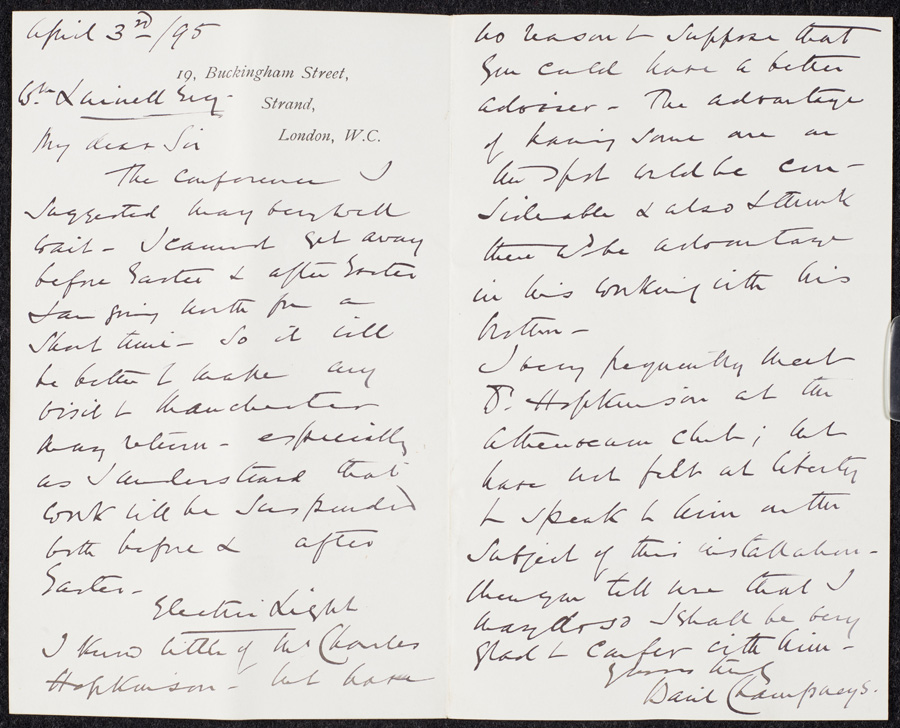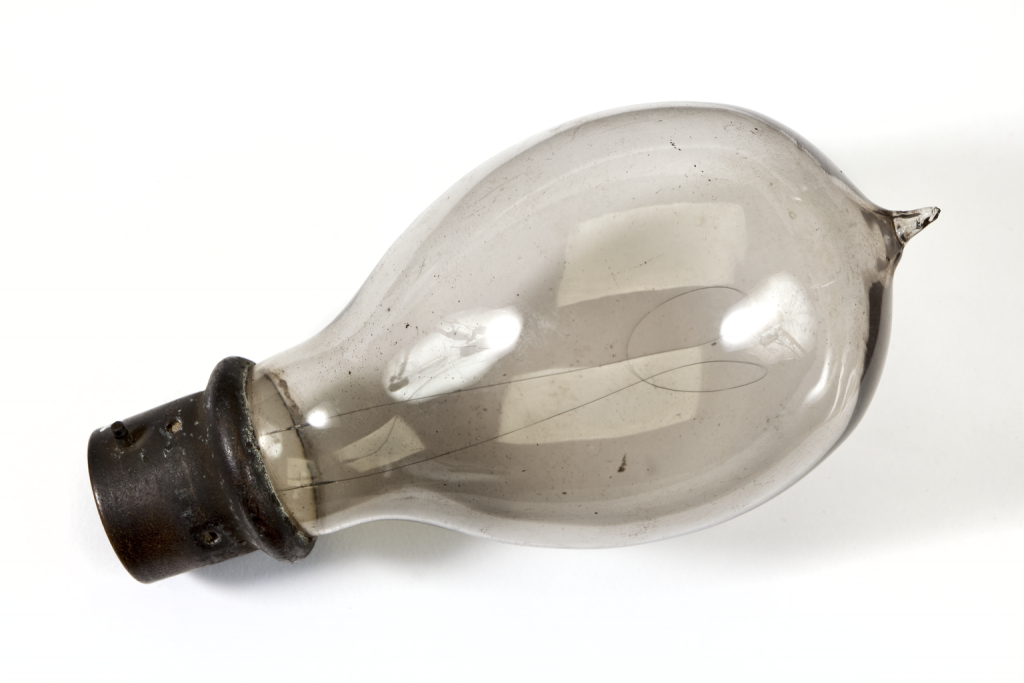Please note: Electricity: The spark of life ended in April 2019. To find out what exhibitions and activities are open today, visit our What’s On section.
This post is the second in a series about the Battle of the Currents. You can read the first post, about the Hopkinson brothers, here.

Credit: Jennifer Boyer (CC BY 2.0)
The John Rylands Library, now home to the University of Manchester’s Special Collections, opened to the public on 1 January 1900. Situated just north of the museum on Deansgate, it was one of the first buildings to use electric light in the city.
Visitors to our current special exhibition, Electricity: The spark of life, encounter a local take on the epic ‘Battle of the Currents‘, fought between Thomas Edison and George Westinghouse in the US. In the UK, Sebastian Ziani de Ferranti convinced the nation that alternating current (AC) was the safest way to generate and distribute high voltage electricity over long distances. In Manchester, the eldest of three engineering brothers, Dr John Hopkinson, influenced Manchester Corporation in the development of a direct current (DC) electricity supply.
Dr Hopkinson designed Manchester’s first power station, located on Dickinson Street in the city centre. An image of the power station can be found on the community website Our Town Story.
That power station opened in July 1893, supplying a surrounding area of half a square mile. It initially only generated power between 17.00 and midnight. Within two months, Dr Hopkinson had devised a five-wire distribution system that allowed consumers to choose a DC supply of 100, 200, 300 or 400 volts, matching the power supply to their needs.

This helped with the uptake of electricity in the city centre and within a couple of years, Dickinson Street power station supplied electricity to a wider suburban area, stretching east and south of the city centre, as far as Failsworth, Audenshaw, Heaton Norris and Withington.
So why was Manchester a DC city when AC was being championed by Ferranti? At the time, a DC generating plant, backed up by storage batteries for off-peak hours, was much cheaper than an AC plant. The short distances of Manchester’s five-wire supply system also meant that the power lost in transmitting the supply was not significant enough to warrant a switch to AC supply.
In 1901, Manchester Corporation built a second power station in Bloom Street, adjacent to Dickinson Street, to meet the increased demand. Bloom Street power station also generated DC electricity. The station is still visible from the Rochdale canal.
Manchester did not get an AC supply until 1902, when the Corporation built Stuart Street power station in Clayton. Stuart Street was a coal-fired central station of a similar type to the central station built by Ferranti at Deptford over a decade earlier. A central power station generates electricity continuously and at high voltages for transmission over longer distances.
When Stuart Street power station opened, it used improved technology to generate high voltage, three-phase AC. However, houses and businesses in the city still used DC electricity so substations converted the AC supply to medium voltage DC for distribution, including a substation located in the engine room of Dickinson Street power station from 1905.
One potential customer for the Corporation’s DC supply was the John Rylands Library, Mrs Enriqueta Rylands’ ambitious memorial to her husband. Mrs Rylands intended from the start that the building would include electric lighting, which she considered cleaner and safer than gas. Work on the library began around the same time that Ferranti developed his 1891 Deptford power station in London, and by the time the lighting scheme was required, Manchester’s Dickinson Street power station had opened.
The original electrical engineer, Thomas Musgrave Heaphy, designed a lighting system that drew DC power from Dickinson Street. Musgrave Heaphy had worked with the Phoenix Assurance Company to develop insurance regulations for electric lighting and had designed a large number of electric lighting installations. But Mrs Rylands was not satisfied with Musgrave Heaphy’s work and replaced him with Dr John Hopkinson’s younger brother Charles in April 1895.
Basil Champneys, the architect who designed the library, wrote to William Linnell, the project manager for the construction of the library, to express his approval of Hopkinson’s appointment:
“The advantage of having someone on the spot would be considerable and also I think would be an advantage in his working with his brother.”

Despite his brother having designed it, Charles Hopkinson did not think that a DC supply from the new Dickinson Street power station was reliable enough for a building like John Rylands Library. As Linnell wrote in reply to Champneys:
“In any scheme for the lighting of the building there must be abundant means of lighting every part …”
A steady supply of light was vital to allow visitors to the library to consult the books it contained. Charles Hopkinson recommended that Mrs Rylands abandon the idea of using the public supply and instead install a local power supply for the library’s lighting system. He suggested the use of dynamos driven by gas engines to supply direct current.
Crossley Brothers Ltd supplied three high-speed horizontal gas engines, and Mather & Platt, where the third Hopkinson brother Edward was a manager, supplied three Edison-Hopkinson dynamos. These dynamos were based on improvements to Thomas Edison’s original design by the eldest brother, John. Forerunners to the Manchester dynamo designed by Edward and John Hopkinson and manufactured by Mather & Platt, they generated electricity on the 110-volt system to power almost 1,500 carbon filament lamps throughout the library.
By 1898, Charles Hopkinson had installed a backup DC supply from Dickinson Street power station to ensure continuity of lighting should the local generating set fail, a reversal of his original belief that the public supply would be less reliable than on-site generation. He needn’t have worried—those dynamos operated from 1896 until 1950 when the library finally became part of the national grid.
The lighting installation at John Rylands Library is one of the earliest large-scale electricity installations to survive largely intact. The Science and Industry Museum collection includes a selection of lightbulbs used in the library. Two are on display in Electricity: The spark of life.

© The Board of Trustees of the Science Museum

© The Board of Trustees of the Science Museum
As the exhibition explores in its final section, it is interesting to think that we are potentially moving towards off-grid generation of electricity to supply homes and businesses as part of the UK government’s commitment to reduce carbon emissions through its carbon budgets. Local DC generation via solar panels and storage of electricity in batteries like the Power Vault example in the exhibition could lead us all to a greener power supply future. I wonder what the Hopkinson brothers would make of that.